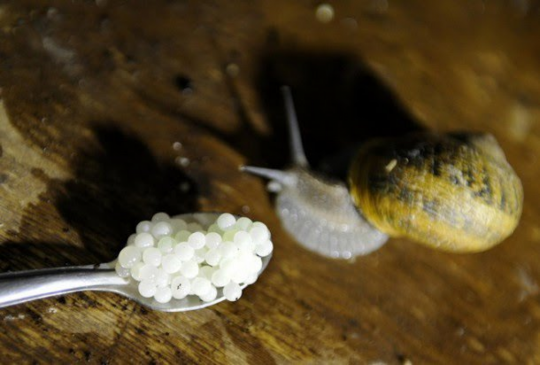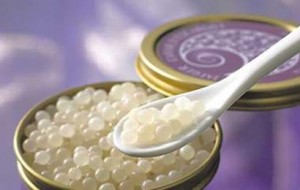Caviale di lumacaSnails caviar
Forse è un po’ prematuro parlarne e soprattutto capire quali risvolti possa avere nel futuro questa prelibatezza che inizia a circolare anche sulle tavole italiane.
L’innovazione in cucina è continua e gli enogastronomi italiani sono sempre lì a fare la loro parte. Così, citando fonti Coldiretti, si scopre che “Tra le tante novità dello scorso anno, sorprendente è la nuova esperienza imprenditoriale di Davide Merlino e Michelangelo Sansone che hanno dato vita a Campofelice di Roccella, nel palermitano, al più grande allevamento di lumache d’Italia, ‘la lumaca Madonita’ da cui si produce un pregiatissimo caviale, certamente il più ‘slow’ del mondo, richiestissimo dai buongustai internazionali”.
Dopo il prelibato caviale di storione e i suoi succedanei molto meno pregiati (di salmone e di lompo), sta venendo alla ribalta il caviale di lumaca. In realtà la produzione è molto limitata e tra i paesi che lo producono oltre l’Italia ci sono la Francia e la Polonia. Una lumaca produce le uova solamente una volta l’anno e la quantità media è di circa 4 grammi. Questi fattori determinano il prezzo di vendita di queste uova che si aggira intorno alle 2000/2500 euro al chilo.
In Francia, patria dell’escargot il caviale di lumaca si produce da diversi anni e i pochi che possono permetterselo ne parlano come un prodotto adorabile.
Grazie all’avviamento del nuovo allevamento, in Sicilia, questa rarità potrebbe diventare un ingrediente speciale dell’alta cucina italiana.

C’è già una collaborazione in atto tra Giovanni Guarnieri, chef del ristorante Don Camillo di Siracusa e l’allevamento di Merlino e Sansone al fine di concentrare gli sforzi per rendere questo prodotto un’eccellenza della cucina italiana.
Si tratta innanzitutto di capire come ottimizzare tale produzione ed aumentare il numero degli allevamenti e nello stesso tempo studiare gli impieghi in cucina in un numero di piatti sempre crescente.
E’ un prodotto dal gusto erbaceo e minerale, delicatissimo, del tutto inedito e molto interessante. Una consistenza molto cremosa, capace di donare un tocco di lussuosità alle diverse preparazioni.
Esso si presenta sotto l’aspetto di piccole sfere bianco perla poco più grandi del caviale di storione. Ve ne sono tuttavia anche di colore rosa.
Costituisce un ottimo ingrediente per rifinire piatti a base di tonno, apportando freschezza ed un delicato sapore terroso.
Altri abbinamenti intriganti si è soliti farli con la zuppa di cocomero, di spinaci e la mousse al cioccolato amaro. Ma questo prodotto da il meglio di sé anche su un semplice crostino di pane imburrato.
Il prodotto è ancora difficile da reperire in Italia ma è in vendita da Harrods a Londra, Hediard e la Grande Epicerie a Parigi, House of Caviar and Fine Food in Olanda, la Bocherie du Lumiard e da Plantin negli Stati Uniti.
Fonte: cucinaconoi.itMaybe it’s a bit premature to talk about and especially to understand what implications may have in the future this delicacy that begins to circulate on Italian tables.
Innovation in the kitchen is continuous and the Italian food and wine are always there to do their part. So, citing Coldiretti, it turns out that “Among the many new features of last year, surprising is the new entrepreneurial experience by Davide Merlino and Michelangelo Sansone that gave birth in Campofelice di Roccella, in Palermo, to the largest breeding snails of Italy, ‘the snail Madonita’ which produce a highly prized caviar, certainly the ‘slow’ in the world, much sought by the international gourmets”.

After the delicious sturgeon caviar and its substitutes much less valuable (salmon and lumpfish), it is coming to the fore the snail caviar. In fact the production is very limited and between countries that produce over Italy there are France and Poland. A snail produce eggs only once a year and the average amount is about 4 grams. These factors determine the selling price of these eggs that is around 2000/2500 euro per kilo.
In France, the homeland of escargot the snail caviar has been produced for several years and the few who can afford it speak of it as a product adorable.
Thanks to the start of the new farm in Sicily, this rarity could become a special ingredient of the Italian haute cuisine.
There is already an ongoing collaboration between Giovanni Guarnieri, chef of the restaurant Don Camillo in Syracuse and the breeding of Merlino and Sansone in order to concentrate efforts to make this product an excellence of Italian cuisine.

It is first of all to understand how to optimize the production and increase the number of farms and at the same time studying the uses in the kitchen in a growing number of dishes.
It is a product with a mineral and herbaceous tasty, extremely delicate, completely new and very interesting.
A very creamy texture, able to give a touch of luxury to different preparations. It comes in the appearance of small white pearl balls slightly larger than the sturgeon caviar. There are however also of pink color.
It is an excellent ingredient to finish tuna dishes, adding freshness and a delicate earthy flavor.
Other intriguing pairings it is customary to make them with the watermelon soup, with spinach and with bitter chocolate mousse. But this product from its best even on a simple toasted buttered bread.
Product is still difficult to find in Italy but is on sale at Harrods in London, and the Grande Epicerie Hediard in Paris, House of Caviar and Fine Food in the Netherlands, the Bocherie du Lumiard and the Plantin in the United States.
Source: cucinaconoi.it





Leave a comment